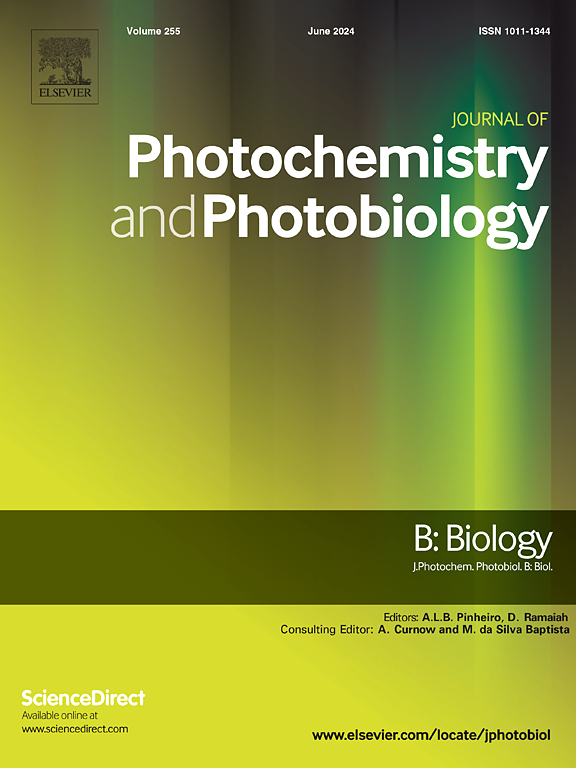Morphological and biochemical analysis along with gene expression dynamics in Lilium ‘Brunello’ under supplemented effect of blue and red light treatment in pin tray soil-less cultivation system
IF 3.7
2区 生物学
Q2 BIOCHEMISTRY & MOLECULAR BIOLOGY
Journal of photochemistry and photobiology. B, Biology
Pub Date : 2025-04-23
DOI:10.1016/j.jphotobiol.2025.113168
引用次数: 0
Abstract
The present research corroborates the influence of supplementation effect of blue light (BL), red light (RL), and the combination of both BL + RL on the morphological traits, biochemical, and expression of key flowering genes assessment in lilium cultivated in bulb forcing soil-less pin trays within a climate-controlled autonomous greenhouse system. The findings revealed profound effect of BL + RL treatment on increased plant height (79.59 cm), stem diameter (10.05 mm), bud length (93.73 mm), and bud diameter (29.87 mm), compared to individual BL and RL treatments and the white light (WL) control. The BL + RL treatment also resulted in shortening the flowering timeline. Maximum flower diameter (18.65 cm) and chlorophyll content index (48.60) were recorded under BL + RL treatment. BL + RL extended post-harvest longevity to 13.2 days, followed by RL (11.6 days). Total chlorophyll content highest at the color bud stage under BL + RL (499.87 μg g−1), though RL treatment sustained the highest levels at the flower stage. Carotenoids content showed a contrasting trend, with RL promoting maximum accumulation during bud stages, while BL + RL enhanced carotenoid synthesis at the flower stage (166.88 μg g−1). Phenol and flavonoid content also reached maximum levels under BL + RL at the color bud stage and anthocyanin content was highest under BL + RL at the flower stage. Additionally, antioxidant activity was significantly higher (86.75 %) in flowers grown under BL + RL. Similarly, up-regulation of flowering genes FT and CO9, particularly observed under the BL + RL treatment at the initial bud and color bud stages, while flowering repressor FLC was down-regulated under all light treatments, facilitating earlier floral induction. The combined BL + RL treatment enhances Lilium cultivation profitability by improving growth, accelerating flowering, increasing flower quality and shelf life, and enabling faster production cycles in controlled Soil-less systems.

蓝、红两种光补强栽培下布鲁内洛百合形态生化及基因表达动态分析
本研究证实了蓝光(BL)、红光(RL)和蓝光+ RL组合对百合形态性状、生化和关键开花基因表达评估的影响。结果表明,与单用BL和RL处理及白光对照相比,BL + RL处理在提高植株高度(79.59 cm)、茎粗(10.05 mm)、芽长(93.73 mm)和芽粗(29.87 mm)方面效果显著。BL + RL处理也导致开花时间缩短。BL + RL处理下植株的最大花径为18.65 cm,叶绿素含量指数为48.60。BL + RL可延长采后寿命至13.2 d, RL次之(11.6 d)。BL + RL处理下总叶绿素含量在花期最高(499.87 μg−1),而RL处理在花期最高。类胡萝卜素含量呈现出相反的趋势,RL促进了芽期类胡萝卜素的最大积累,而BL + RL促进了花期类胡萝卜素的合成(166.88 μg−1)。酚和类黄酮含量在花期最高,花青素含量在花期最高。此外,BL + RL处理下的花抗氧化活性显著提高(86.75%)。同样,在BL + RL处理下,开花基因FT和CO9在初芽期和色芽期上调,而开花抑制基因FLC在所有光处理下均下调,有利于更早的诱导成花。在控制无土系统中,BL + RL联合处理通过促进生长、加速开花、提高花的质量和保质期以及加快生产周期,提高了百合种植的盈利能力。
本文章由计算机程序翻译,如有差异,请以英文原文为准。
求助全文
约1分钟内获得全文
求助全文
来源期刊
CiteScore
12.10
自引率
1.90%
发文量
161
审稿时长
37 days
期刊介绍:
The Journal of Photochemistry and Photobiology B: Biology provides a forum for the publication of papers relating to the various aspects of photobiology, as well as a means for communication in this multidisciplinary field.
The scope includes:
- Bioluminescence
- Chronobiology
- DNA repair
- Environmental photobiology
- Nanotechnology in photobiology
- Photocarcinogenesis
- Photochemistry of biomolecules
- Photodynamic therapy
- Photomedicine
- Photomorphogenesis
- Photomovement
- Photoreception
- Photosensitization
- Photosynthesis
- Phototechnology
- Spectroscopy of biological systems
- UV and visible radiation effects and vision.

 求助内容:
求助内容: 应助结果提醒方式:
应助结果提醒方式:


